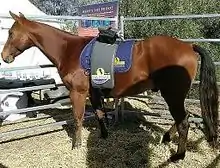Equine massage
Equine massage is the practice of massage on horses. Beginning in the early 1990s, it has been a growing field of equine therapy, utilized for both day-to-day riding and post-trauma rehabilitation. Proponents list a number of positive effects, including the improvement of movement and the reduction of pain and stress responses. Scientific study is beginning to demonstrate possible benefits, although more study is needed.


Practice
Hands-on therapies, including massage, acupressure and joint mobilization, were one of the fastest growing equine therapy categories in the early 1990s.[1]
Equine massage uses the hands, fingers and elbows of the therapist, as well as other tools, including tennis balls and vibrating tools. During the massage, the soft tissue is manipulated with the goal of loosening tight muscles, joints, tendons, scar tissue and edema; increasing blood flow and lymphatic activity; and reducing stress. Equine massage is used in exercise warm-up and post-injury or surgery rehabilitation.[1]
Scientific study
Massage in horses uses many techniques first used for human massage, and it is becoming more common in both competitive equestrian disciplines and pleasure riding. Proponents say that equine massage improves movement and reduces pain and stress responses. Research has shown that massage affects the muscular system at the cellular and fascial levels, as well as physiologic systems. Preliminary research has been conducted that demonstrates possible benefits in exercise recovery, but additional rigorous research is needed to further examine these possibilities.[2]
A 2015 study done at Western Kentucky University entitled: "Horses' Responses to Receiving The Masterson Method® of Integrated Equine Performance Bodywork™ Treatments" documents changes in comfort levels after receiving bodywork. Research documentation included pre and post treatment evaluations, the treatments, owner questionnaires, and cribbing observations. Also, all evaluation and treatment sessions were videotaped with the intent of further analysis for changes in range of motion, flexibility, and comfort level as applicable. This research demonstrated that these bodywork sessions may reduce somatic pain and consequently reduce lameness, aggression and possibly cribbing. At the conclusion of this study each horse had an improved attitude, and their individual health issues were diminished.[3]
A 2013 study of 20 riding horses examined the differences in equine behavior among horses resting, receiving a massage and receiving a treatment of Tellington TTouchTM Method created by Linda Tellington-Jones. The study determined that the horses receiving TTouch had the highest levels of relaxed and positive behaviors, while the resting horses showed signs of boredom and the horses receiving massage therapy tended to move around more and behave in a less relaxed manner. The scientists who conducted the experiment confirmed that further study of various therapy techniques is needed.[4]
Regulation, training and associations
In the United States, the legal requirements vary by state and are determined by each state's veterinary board. Presently, some states require veterinary supervision while others do not.[5] Many schools offer certification programs in the areas of animal and companion massage. Some of these schools are approved by the National Certification Board for Therapeutic Massage and Bodywork (NCBTMB).[6] The International Association of Animal Massage & Bodywork (IAAMB) is an association of animal massage and bodywork practitioners, including equine massage therapists.[7]
References
- Porter, Mimi (May 1, 1998). "Hands-On Therapies for the Horse". The Horse.
- Scott, Mike; Swensen, Lee Ann (September 2009). "Evaluating the Benefits of Equine Massage Therapy: A Review of the Evidence and Current Practices". Journal of Equine Veterinary Science. 29 (9): 687–697. doi:10.1016/j.jevs.2009.07.017.
- Beu, Carla (2015). "Horses' Responses to Receiving Masterson Method® Integrated Equine Performance Bodywork™ Treatments". Western Kentucky University, Top Scholar.
- Lesté-Lasserre, Christa (August 8, 2013). "Study: T-Touch 'Positively Accepted' by Saddle Horses". The Horse.
- "Animal Massage Laws by State". International Association of Animal Massage & Bodywork. Retrieved 2013-11-23.
- "Continuing Education Provider Search Results". National Certification Board for Therapeutic Massage and Bodywork. Retrieved 2013-11-23.
- "Welcome to the IAAMB/ACWT". International Association of Animal Massage & Bodywork. Archived from the original on 2013-12-02. Retrieved 2013-11-23.
